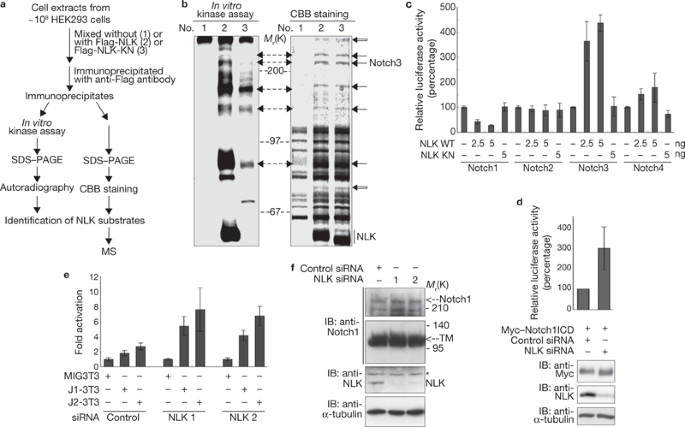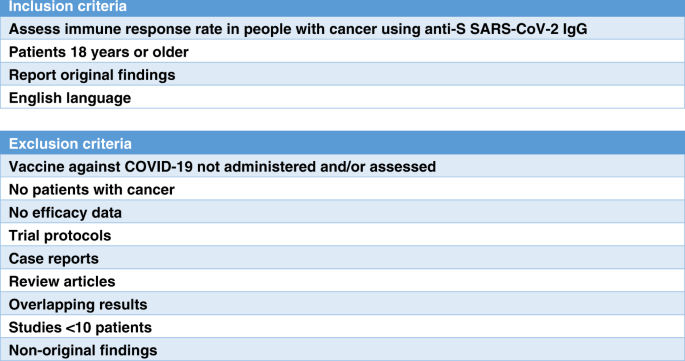
- Select a language for the TTS:
- UK English Female
- UK English Male
- US English Female
- US English Male
- Australian Female
- Australian Male
- Language selected: (auto detect) - EN
Play all audios:
ABSTRACT The Notch signalling pathway has a crucial function in determining cell fates in multiple tissues within metazoan organisms1. On binding to ligands, the Notch receptor is cleaved
proteolytically and releases its intracellular domain (NotchICD). The NotchICD enters the nucleus and acts cooperatively with other factors to stimulate the transcription of target genes.
High levels of Notch-mediated transcriptional activation require the formation of a ternary complex consisting of NotchICD, CSL (CBF-1, suppressor of hairless, LAG-1) and a Mastermind family
member2,3,4,5. However, it is still not clear how the formation of the ternary complex is regulated. Here we show that Nemo-like kinase (NLK) negatively regulates Notch-dependent
transcriptional activation by decreasing the formation of this ternary complex. Using a biochemical screen, we identified Notch as a new substrate of NLK. NLK-phosphorylated Notch1ICD is
impaired in its ability to form a transcriptionally active ternary complex. Furthermore, knockdown of NLK leads to hyperactivation of Notch signalling and consequently decreases neurogenesis
in zebrafish. Our results both define a new function for NLK and reveal a previously unidentified mode of regulation in the Notch signalling pathway. Access through your institution Buy or
subscribe This is a preview of subscription content, access via your institution ACCESS OPTIONS Access through your institution Subscribe to this journal Receive 12 print issues and online
access $209.00 per year only $17.42 per issue Learn more Buy this article * Purchase on SpringerLink * Instant access to full article PDF Buy now Prices may be subject to local taxes which
are calculated during checkout ADDITIONAL ACCESS OPTIONS: * Log in * Learn about institutional subscriptions * Read our FAQs * Contact customer support SIMILAR CONTENT BEING VIEWED BY OTHERS
INHIBITION OF WNT SIGNALLING BY NOTCH VIA TWO DISTINCT MECHANISMS Article Open access 27 April 2021 NOTCH INTRACELLULAR DOMAINS FORM TRANSCRIPTIONALLY ACTIVE HETERODIMERIC COMPLEXES ON
SEQUENCE-PAIRED SITES Article Open access 02 January 2024 FUNCTIONAL ROLE OF THE FRIZZLED LINKER DOMAIN IN THE WNT SIGNALING PATHWAY Article Open access 05 May 2022 REFERENCES *
Artavanis-Tsakonas, S., Rand, M. D. & Lake, R. J. Notch signaling: cell fate control and signal integration in development. _Science_ 284, 770–776 (1999). Article CAS Google Scholar *
Bray, S. J. Notch signalling: a simple pathway becomes complex. _Nature Rev. Mol. Cell Biol._ 7, 678–689 (2006). CAS Google Scholar * Wu, L. et al. MAML1, a human homologue of Drosophila
mastermind, is a transcriptional co-activator for NOTCH receptors. _Nature Genet._ 26, 484–489 (2000). Article CAS Google Scholar * Kitagawa, M. et al. A human protein with sequence
similarity to _Drosophila_ mastermind coordinates the nuclear form of notch and a CSL protein to build a transcriptional activator complex on target promoters. _Mol. Cell. Biol._ 21,
4337–4346 (2001). Article CAS Google Scholar * Oyama, T. et al. Mastermind-1 is required for Notch signal-dependent steps in lymphocyte development in vivo. _Proc. Natl Acad. Sci. USA_
104, 9764–9769 (2007). Article CAS Google Scholar * Choi, K. W. & Benzer, S. Rotation of photoreceptor clusters in the developing _Drosophila_ eye requires the nemo gene. _Cell_ 78,
125–136 (1994). Article CAS Google Scholar * Meneghini, M. D. et al. MAP kinase and Wnt pathways converge to downregulate an HMG-domain repressor in _Caenorhabditis elegans_. _Nature_
399, 793–797 (1999). Article CAS Google Scholar * Thorpe, C. J. & Moon, R. T. nemo-like kinase is an essential co-activator of Wnt signaling during early zebrafish development.
_Development_ 131, 2899–2909 (2004). Article CAS Google Scholar * Kortenjann, M. et al. Abnormal bone marrow stroma in mice deficient for nemo-like kinase, Nlk. _Eur. J. Immunol._ 31,
3580–3587 (2001). Article CAS Google Scholar * Ishitani, T. et al. The TAK1–NLK–MAPK-related pathway antagonizes signalling between β-catenin and transcription factor TCF. _Nature_ 399,
798–802 (1999). Article CAS Google Scholar * Ishitani, T., Ninomiya-Tsuji, J. & Matsumoto, K. Regulation of lymphoid enhancer factor 1/T-cell factor by mitogen-activated protein
kinase-related Nemo-like kinase-dependent phosphorylation in Wnt/β-catenin signaling. _Mol. Cell. Biol._ 23, 1379–1389 (2003). Article CAS Google Scholar * Kanei-Ishii, C. et al. Wnt-1
signal induces phosphorylation and degradation of c-Myb protein via TAK1, HIPK2, and NLK. _Genes Dev._ 18, 816–829 (2004). Article CAS Google Scholar * Kojima, H. et al. STAT3 regulates
Nemo-like kinase by mediating its interaction with IL-6-stimulated TGFβ-activated kinase 1 for STAT3 Ser-727 phosphorylation. _Proc. Natl Acad. Sci. USA_ 102, 4524–4529 (2005). Article CAS
Google Scholar * Ohkawara, B. et al. Role of the TAK1–NLK–STAT3 pathway in TGF-β-mediated mesoderm induction. _Genes Dev._ 18, 381–6 (2004). Article CAS Google Scholar * Verheyen, E.
M., Purcell, K. J., Fortini, M. E. & Artavanis-Tsakonas, S. Analysis of dominant enhancers and suppressors of activated Notch in _Drosophila_. _Genetics_ 144, 1127–1141 (1996). CAS
PubMed PubMed Central Google Scholar * Kankel, M. W. et al. Investigating the genetic circuitry of mastermind in _Drosophila_, a notch signal effector. _Genetics_ 177, 2493–2505 (2007).
Article CAS Google Scholar * Zhou, S. et al. SKIP, a CBF1-associated protein, interacts with the ankyrin repeat domain of NotchIC to facilitate NotchIC function. _Mol. Cell. Biol._ 20,
2400–2410 (2000). Article CAS Google Scholar * Takke, C., Dornseifer, P., v. Weizsacker, E. & Campos-Ortega, J. A. _her4_, a zebrafish homologue of the _Drosophila_ neurogenic gene
E(spl), is a target of NOTCH signalling. _Development_ 126, 1811–1821 (1999). CAS PubMed Google Scholar * Yeo, S., Kim, M. J., Kim, H., Huh, T. & Chitnis, A. B. Fluorescent protein
expression driven by _her4_ regulatory elements reveals the spatiotemporal pattern of Notch signaling in the nervous system of zebrafish embryos. _Dev. Biol._ 301, 555–567 (2007). Article
CAS Google Scholar * Hyodo-Miura, J. et al. Involvement of NLK and Sox11 in neural induction in _Xenopus_ development. _Genes Cells_ 7, 487–496 (2002). Article CAS Google Scholar *
Bigas, A., Martin, D. I. & Milner, L. A. Notch1 and Notch2 inhibit myeloid differentiation in response to different cytokines. _Mol. Cell Biol._ 18, 2324–2333 (1998). Article CAS
Google Scholar * Inglés-Esteve, J., Espinosa, L., Milner, L. A., Caelles, C. & Bigas, A. Phosphorylation of Ser2078 modulates the Notch2 function in 32D cell differentiation. _J. Biol.
Chem._ 276, 44873–44880 (2001). Article Google Scholar * Kurooka, H., Kuroda, K. & Honjo, T. Roles of the ankyrin repeats and C-terminal region of the mouse notch1 intracellular
region. _Nucleic Acids Res._ 26, 5448–5455 (1998). Article CAS Google Scholar * Kurooka, H. & Honjo, T. Functional interaction between the mouse notch1 intracellular region and
histone acetyltransferases PCAF and GCN5. _J. Biol. Chem._ 275, 17211–17220 (2000). Article CAS Google Scholar * Pufall, M. A. et al. Variable control of Ets-1 DNA binding by multiple
phosphates in an unstructured region. _Science_ 309, 142–145 (2005). Article CAS Google Scholar * Zhao, Y., Tong, C. & Jiang, J. Hedgehog regulates smoothened activity by inducing a
conformational switch. _Nature_ 450, 252–258 (2007). Article CAS Google Scholar * Minoguchi, S. et al. RPB-L, a transcription factor related to RBP-Jκ. _Mol. Cell. Biol._ 17, 2679–2687
(1997). Article CAS Google Scholar * Raya, A. et al. Notch activity induces Nodal expression and mediates the establishment of left-right asymmetry in vertebrate embryos. _Genes Dev._ 17,
1213–1218 (2003). Article CAS Google Scholar * Kim, C. H. et al. Zebrafish elav/HuC homologue as a very early neuronal marker. _Neurosci. Lett._ 216, 109–112 (1996). Article CAS Google
Scholar * Mizutani, T. et al. Conservation of the biochemical mechanisms of signal transduction among mammalian Notch family members. _Proc. Natl Acad. Sci. USA_ 98, 9026–9031 (2001).
Article CAS Google Scholar * Shimizu, K. et al. Functional diversity among Notch1, Notch2, and Notch3 receptors. _Biochem. Biophys. Res. Commun._ 291, 775–779 (2002). Article CAS Google
Scholar * Lin, S. E. et al. Identification of new human mastermind proteins defines a family that consists of positive regulators for notch signaling. _J. Biol. Chem._ 277, 50612–50620
(2002). Article CAS Google Scholar * Wettstein, D. A., Turner, D. L. & Kintner, C. The _Xenopus_ homolog of _Drosphila_ Suppressor of Hairless mediates Notch signaling during primary
neurogenesis. _Development_ 124, 693–702 (1997). CAS PubMed Google Scholar Download references ACKNOWLEDGEMENTS We thank T. Honjo, T. C. Südhof, U. Lendahl, K. Yasutomo, C. Kintner, D.
Hayward, J. D. Griffin, L. Wu, M. Takeichi, S. Chiba, A. Kikuchi, H. Fujisawa and K. Hozumi for providing plasmid vectors, antibody and cultured cells; H. Matsuo for technical assistance;
members of the H. Aiba laboratory (especially T. Sunohara) for technical advice; and J. Ninomiya-Tsuji for helpful discussions. This research was supported by the Yamada Science Foundation
(T.I.), the Astellas Foundation for Research on Metabolic Disorders (T.I. and M.I.), the Program for Improvement of Research Environment for Young Researchers from SCF commissioned by MEXT
of Japan (T.I. and M.I.), and the Grants-in-Aid for Scientific Research programs in Japan (T.I., K.M. and M.I.). AUTHOR INFORMATION AUTHORS AND AFFILIATIONS * Unit on Nervous Development
Systems, 464-8602, Nagoya, Japan Tohru Ishitani, Tomoko Hirao, Miho Isoda & Motoyuki Itoh * Division of Biological Science, Group of Signal Transduction, Laboratory of Cell Regulation,
Graduate School of Science, 464-8602, Nagoya, Japan Tohru Ishitani, Maho Suzuki & Kunihiro Matsumoto * Institute for Advanced Research, Nagoya University, 464-8602, Nagoya, Japan
Motoyuki Itoh * Division of Cell Regulation Systems, Department of Post-Genome Science Center, Medical Institute of Bioregulation, Kyushu University, 812-8582, Fukuoka, Japan Tohru Ishitani
& Shizuka Ishitani * Department of Molecular and Tumor Pathology, Chiba University Graduate School of Medicine, 260-8670, Chiba, Japan Kenichi Harigaya & Motoo Kitagawa Authors *
Tohru Ishitani View author publications You can also search for this author inPubMed Google Scholar * Tomoko Hirao View author publications You can also search for this author inPubMed
Google Scholar * Maho Suzuki View author publications You can also search for this author inPubMed Google Scholar * Miho Isoda View author publications You can also search for this author
inPubMed Google Scholar * Shizuka Ishitani View author publications You can also search for this author inPubMed Google Scholar * Kenichi Harigaya View author publications You can also
search for this author inPubMed Google Scholar * Motoo Kitagawa View author publications You can also search for this author inPubMed Google Scholar * Kunihiro Matsumoto View author
publications You can also search for this author inPubMed Google Scholar * Motoyuki Itoh View author publications You can also search for this author inPubMed Google Scholar CONTRIBUTIONS
T.I. designed the research, performed most of the experiments, analysed data and wrote the paper. T.H., M.S., M. Isoda and S.I. performed experiments and analysed data. K.H. participated in
discussions and helped write the paper. M.K. designed the research and performed the experiments, analysed data and wrote the paper. K.M. designed the initial experiments to identify NLK
substrates, participated discussions, and helped write the paper. M. Itoh designed the project and experiments, supervised the research, coordinated experiments and wrote the paper.
CORRESPONDING AUTHORS Correspondence to Tohru Ishitani or Motoyuki Itoh. ETHICS DECLARATIONS COMPETING INTERESTS The authors declare no competing financial interests. SUPPLEMENTARY
INFORMATION SUPPLEMENTARY INFORMATION Supplementary Information (PDF 1585 kb) RIGHTS AND PERMISSIONS Reprints and permissions ABOUT THIS ARTICLE CITE THIS ARTICLE Ishitani, T., Hirao, T.,
Suzuki, M. _et al._ Nemo-like kinase suppresses Notch signalling by interfering with formation of the Notch active transcriptional complex. _Nat Cell Biol_ 12, 278–285 (2010).
https://doi.org/10.1038/ncb2028 Download citation * Received: 13 October 2009 * Accepted: 14 December 2009 * Published: 31 January 2010 * Issue Date: March 2010 * DOI:
https://doi.org/10.1038/ncb2028 SHARE THIS ARTICLE Anyone you share the following link with will be able to read this content: Get shareable link Sorry, a shareable link is not currently
available for this article. Copy to clipboard Provided by the Springer Nature SharedIt content-sharing initiative






